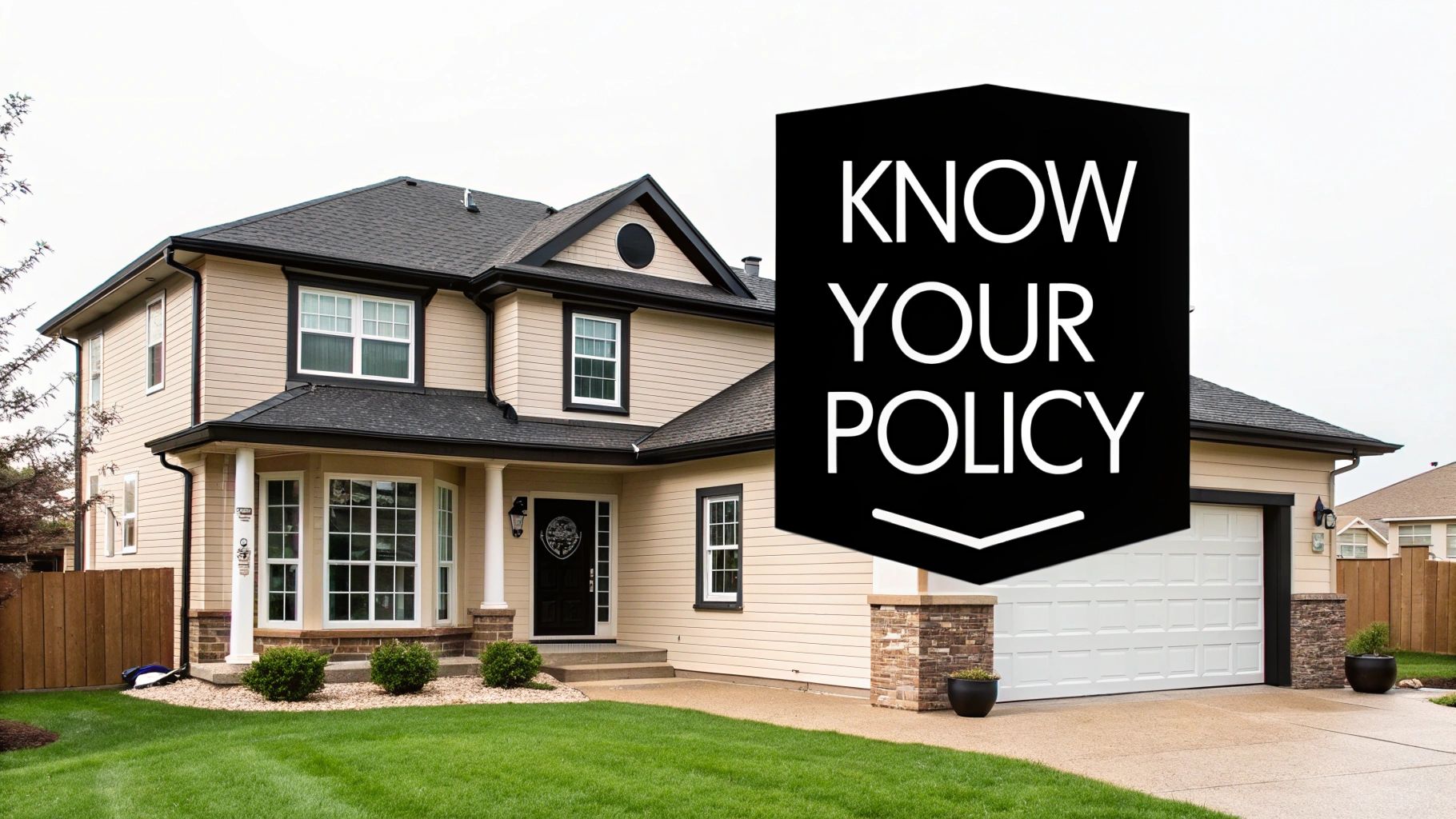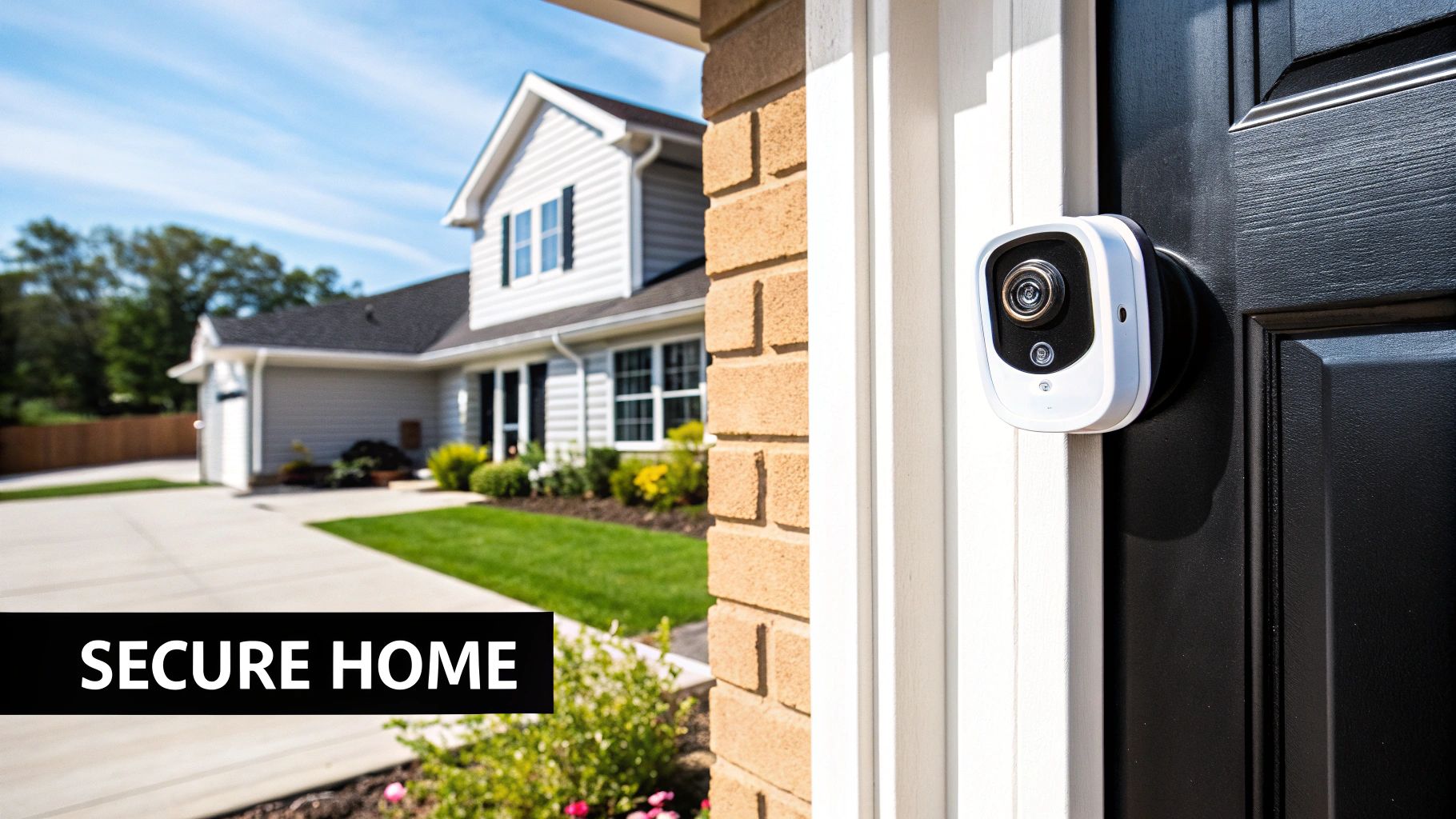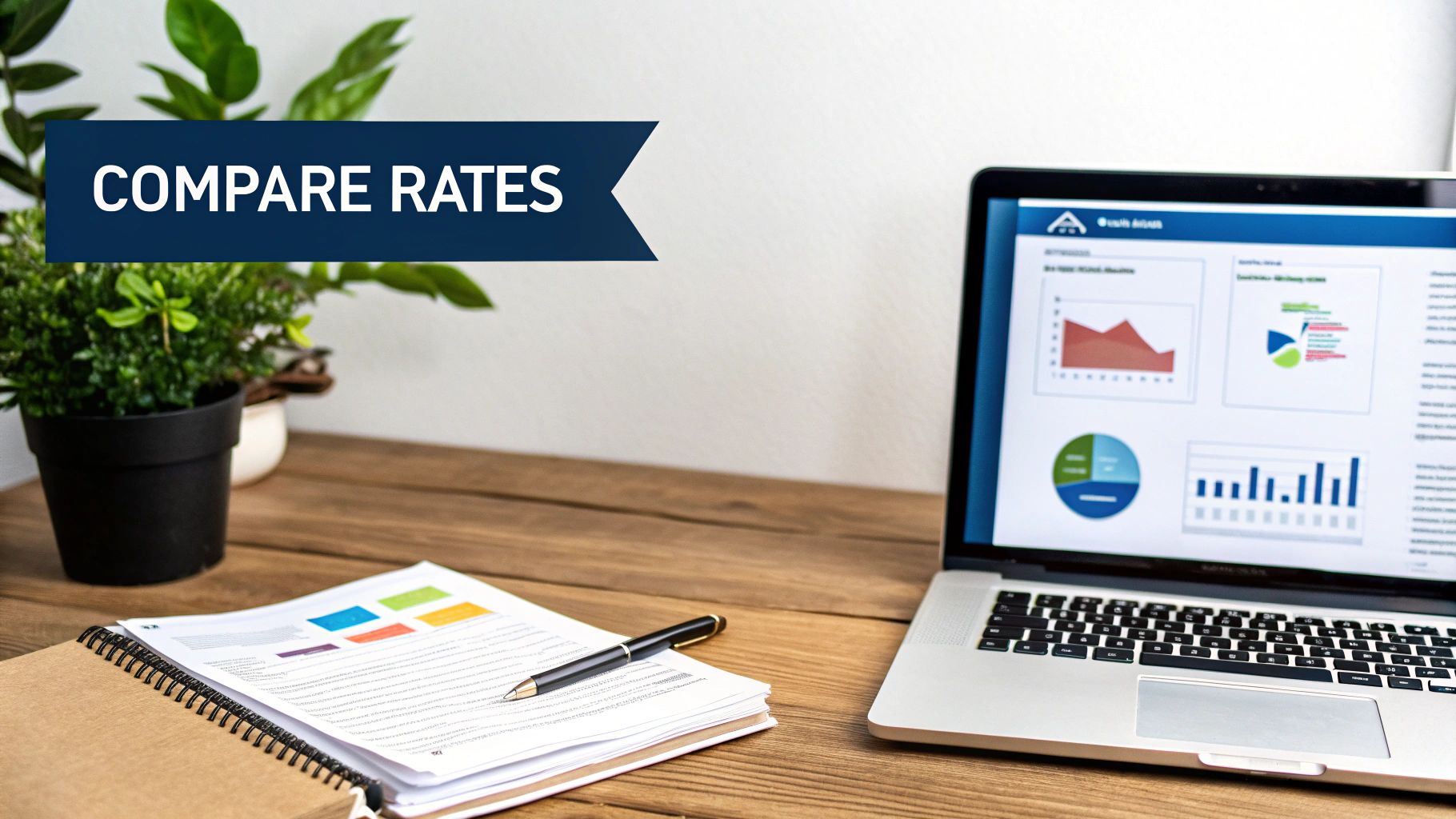Understanding What Drives Your Insurance Costs

Understanding how home insurance premiums are calculated is the first step toward potentially lowering them. Insurers use a complex system to assess risk, meaning your premium reflects your home's perceived vulnerability. Let's unpack some of these often hidden factors.
Location, Location, Location: Geography and Your Premium
Your home's location significantly influences your premium. Homes in areas prone to natural disasters, such as hurricanes or wildfires, typically face higher premiums. Similarly, areas with higher crime rates can also increase insurance costs. Insurers view these locations as carrying a greater risk of claims. Understanding the basics of insurance is key to finding potential savings.
Construction and Age: The Impact of Your Home's Structure
The materials used to build your home and its age are also key factors. Homes constructed with fire-resistant materials, like brick, are often less expensive to insure than wood-framed homes. Older homes may face higher premiums due to outdated plumbing or electrical systems, which represent a higher risk. Regular home maintenance can positively impact your insurance bill.
Credit Score Correlation: A Surprising Factor
Your credit score can influence your home insurance premium. Insurers use credit-based insurance scores as part of their risk assessment. Studies indicate a correlation between lower credit scores and a higher likelihood of filing claims. Improving your credit score could potentially lead to lower insurance rates. Learn more about the factors influencing home insurance costs: Understanding the top factors that drive up your home insurance costs.
Climate Change and Rising Costs: A Growing Concern
Climate-related perils are increasingly impacting insurance costs. Between 2018 and 2022, homeowners insurance premiums increased 8.7% more than inflation, driven largely by rising climate risks. This is particularly evident in regions prone to natural disasters. Investing in climate-resilient home improvements can potentially lower premiums by reducing a property's risk profile. Some insurers offer discounts for homes built or retrofitted to withstand severe weather. For more detailed statistics, see this resource: https://home.treasury.gov/news/press-releases/jy2791.
By understanding these factors, you can identify your home's unique risk profile and make informed decisions about your home insurance. This knowledge is invaluable for exploring strategies to potentially reduce premiums.
Home Improvements That Slash Insurance Premiums
Not all home improvements offer the same return on investment when it comes to insurance premiums. While a new kitchen might boost your home's value, it won't necessarily lower your insurance costs. This article focuses on upgrades that insurers reward with lower premiums.
Security Systems: A Powerful Deterrent
A robust security system can significantly reduce your home insurance premiums. Insurers see homes with security systems as lower risk, deterring burglaries and potential claims. Systems with features like central monitoring, burglar alarms, and smoke detectors often bring the biggest discounts. Some insurers offer additional discounts for smart home technology integrated with your security system.
Adding security system features can significantly impact your home insurance premium. Consider these: professional monitoring, burglar/intrusion alarms, and interconnected smoke detectors.
Disaster-Proofing: Protecting Your Investment
Disaster-proofing not only protects your property but can also lower your insurance premiums. Reinforcing your roof can lessen wind damage, while storm shutters can protect windows during hurricanes. These upgrades show a proactive approach to risk reduction, making your home less risky for insurers.
Think about fortifying your home against natural disasters: reinforcing your roof against high winds or installing storm shutters to protect windows from hurricane damage. These improvements showcase proactive risk management, which is often rewarded by insurance providers.
Let's look at some typical home improvements that can result in insurance savings:
Insurance-Saving Home Improvements
| Improvement Type | Average Cost | Typical Premium Reduction | ROI Timeline |
|---|---|---|---|
| Security System (Monitored) | $500 – $1,500 + $20-$50/month | 5% – 20% | 1-3 Years |
| Impact-Resistant Roofing | $10,000 – $30,000 | 5% – 35% (varies by region) | 5-10 Years |
| Storm Shutters/Impact Windows | $2,000 – $8,000 | 2% – 10% (varies by region) | 3-7 Years |
| Water Leak Detection System | $200 – $500 + potential monitoring fees | 2% – 5% | 1-2 Years |
This table provides a general overview. Actual costs and savings depend on your location, insurer, and specific improvements. Remember to contact your insurance provider to understand what discounts they offer.
Key takeaway: while some improvements have a higher upfront cost, their long-term savings on premiums can result in a significant return on investment over time.
Water Detection Technology: Insurers' New Favorite
Water damage is a leading cause of home insurance claims. Installing water leak detection systems has become increasingly popular with insurers. These systems detect even small leaks early, preventing extensive damage and costly claims. The low installation cost and substantial potential savings make this upgrade attractive for lowering premiums.
Consider installing a water leak detection system. These systems can alert you to even small leaks, which, when caught early can often save you from a much larger problem down the road.
Documenting Improvements: A Crucial Step
Simply making improvements isn't enough. You must document them to receive discounts. Provide your insurer with receipts, invoices, and certifications. Keep records of all upgrades, including installation dates and model numbers. Thorough documentation helps demonstrate the value of your improvements to your insurer. By following these strategies, you can make smart investments that both improve your home and lower your insurance costs.
Be sure to keep thorough records of all your home improvements to share with your insurance provider.
Rising construction and repair costs contribute to higher premiums. From 2020 to 2022, the cumulative replacement costs for home repairs increased by 55%, outpacing general inflation. Insurers pass these costs on to policyholders. Improving home resilience through upgrades can reduce claims and lead to lower premiums over time. Learn more about this issue: How is climate change impacting home insurance markets?
Smart Policy Adjustments That Reduce Costs

Your current home insurance policy likely has hidden opportunities for savings. This section explores strategic adjustments that can lower your costs without sacrificing essential coverage.
Optimizing Your Deductible: Finding the Right Balance
Your deductible is the amount you pay out-of-pocket before your insurance coverage begins. Opting for a higher deductible often results in lower premiums. This is because you're taking on more financial responsibility. However, it's crucial to choose a deductible you can comfortably afford in the event of a claim.
For instance, increasing your deductible from $500 to $1,000 could lead to significant annual savings. But are you prepared to pay that $1,000 if needed? Finding the right balance between savings and risk is key.
Right-Sizing Your Coverage: Avoiding Unnecessary Expenses
Many homeowners unknowingly over-insure their properties. Your dwelling coverage should equal the cost to rebuild your home, not its market value. These are two different numbers. Overestimating your rebuild cost results in higher premiums than necessary.
Consulting a reputable contractor or appraiser can help you determine an accurate rebuild cost. This ensures adequate coverage without overspending.
Evaluating Add-ons: Choosing Wisely
Insurance policies often include optional add-ons. Some, like water backup coverage, can provide valuable protection, especially for homes in flood-prone areas. Others, such as identity theft protection, might already be included in other services you have.
Carefully consider the value and necessity of each add-on before including it in your policy. This prevents paying for coverage you don't need or already have.
Bundling Policies: Comparing and Contrasting
Bundling home and auto insurance with the same provider often results in discounts. However, don't assume that bundling automatically offers the best deal. Compare the bundled price with quotes for separate policies from different insurers.
This comparison shopping helps you determine if bundling truly offers the most cost-effective solution. It also helps you avoid being swayed by marketing tactics and focus on actual savings.
Understanding Coverage Types: Protecting Your Investment
Actual cash value (ACV) coverage considers depreciation when settling a claim. Replacement cost coverage, on the other hand, pays to replace damaged items with new ones, regardless of depreciation.
While ACV coverage typically has lower premiums, it could leave you significantly underinsured after a major loss. Understanding the distinction between these coverage types is essential for balancing affordable premiums with adequate protection. Reinsurance costs also play a significant role in determining home insurance premiums. Between 2018 and 2023, U.S. property and casualty reinsurance costs doubled, creating what some experts call a "reinsurance shock."
This directly impacts homeowners by driving up insurance costs. To mitigate these rising costs, homeowners can explore bundling policies or researching alternative insurers offering more competitive rates. Learn more about this issue: Disaster Risk and Rising Home Insurance Premiums. By proactively managing your policy and making informed decisions, you can significantly reduce your home insurance expenses while maintaining the necessary coverage.
Strategic Shopping Tactics for Better Rates

Finding the best home insurance rates isn't about quickly browsing a few websites. It's about having a well-defined strategy. This involves understanding how the insurance market works and using effective tactics to get the best deal.
Timing Your Insurance Shopping: Seasonal and Life Event Strategies
Much like airfare, home insurance rates can change. Understanding these fluctuations can save you a significant amount of money. Shopping during the off-season, meaning times that avoid major holidays and periods of severe weather, can often result in lower premiums. This is because insurers are competing for business during slower periods.
Life changes also create opportunities for savings. Getting married, buying a new house, or completing major home improvements can often make you eligible for discounts. Timing your insurance shopping around these events helps maximize your savings.
Comparing Apples to Apples: Creating Consistent Quotes
Accurate quotes are essential for effective comparison shopping. Make sure each quote includes the same coverage levels and deductibles. This ensures a fair comparison of the actual costs. It’s similar to grocery shopping: you can’t accurately compare a name-brand cereal to a generic brand without considering the quantity and ingredients.
Negotiating With Insurers: Leveraging Competing Offers
Don't hesitate to negotiate once you have comparable quotes. Presenting competing offers from other insurers can sometimes motivate your current provider to match or even beat those rates. This is a common and accepted practice in the insurance industry.
Choosing the Right Agent or Company: Independent vs. Direct
Independent agents work with multiple insurance companies, providing a wider array of options. Direct insurers, conversely, sell policies directly to consumers. The best choice depends on individual needs and preferences. Independent agents can be helpful for those seeking personalized service, while direct insurers might suit those comfortable with online research and purchasing.
Utilizing Comparison Websites Wisely: Avoiding Bias
Comparison websites offer a convenient way to gather multiple quotes quickly. However, it’s important to be aware that some websites might favor certain insurers due to advertising partnerships. Research and choose reputable websites known for providing unbiased information.
Understanding Risk Factors: Identifying Hidden Opportunities
Each insurer assesses risk differently. One might penalize older roofs, while another focuses on proximity to fire hydrants. Understanding these nuances lets you target insurers aligned with your home’s characteristics. This can uncover savings opportunities based on your home's specific profile. You might find this resource helpful: How to master the right insurance for your needs.
Before you begin shopping for home insurance, take a look at the checklist below. It summarizes key information to gather and questions to ask insurers.
To help you prepare for insurance shopping, here's a helpful checklist:
Insurance Shopping Checklist
Essential information to gather and questions to ask when comparing home insurance policies
| Category | Information to Gather | Questions to Ask Insurers |
|---|---|---|
| Property Details | Age of home, construction materials, square footage, recent renovations | What discounts are available for updated roofing, plumbing, or electrical systems? |
| Coverage Needs | Value of belongings, liability limits needed | Does the policy cover specific perils like water backup or earthquake damage? What are the limits for personal liability coverage? |
| Deductibles | Comfortable deductible amount | How does choosing a higher deductible affect my premium? |
| Discounts | Available discounts (e.g., security systems, bundled policies) | Are there discounts for being claims-free, having multiple policies, or belonging to certain organizations? |
| Claims History | Details of past insurance claims | How will past claims affect my premium? |
This checklist ensures you're well-prepared to compare policies effectively and choose the coverage that best suits your needs.
By strategically approaching the insurance market and using these tactics, you can secure the best possible rates for your home insurance. This proactive approach empowers you to make informed decisions, save money, and maintain adequate coverage.
Hidden Discounts Most Homeowners Never Claim

Many homeowners focus on the more obvious ways to save on home insurance, like raising their deductible. But a wealth of hidden discounts often remains untapped. These overlooked savings can significantly impact your premiums. Let’s explore some of these often-missed opportunities.
Beyond the Basics: Uncommon Profession-Based Discounts
While discounts for military members and teachers are common knowledge, many other professions qualify for lesser-known savings. Some insurers extend these discounts to first responders, medical professionals, and engineers. These discounts acknowledge the statistically lower risk profiles often linked to these careers. Simply mentioning your profession during the quoting process could reveal potential savings.
Lifestyle Discounts: Retirement and More
Your lifestyle could also qualify you for discounts. Retired individuals, for example, are often eligible for premium reductions. Retirees are typically home more, which increases the likelihood of early fire detection and can deter burglaries. This enhanced security often translates to lower insurance costs. Beyond retirement, some insurers offer discounts for non-smokers or members of specific professional organizations.
Loyalty Programs: Rewarding Existing Customers
Many insurance companies offer loyalty programs that reward long-term customers with discounts. These programs are often unadvertised and require customers to inquire directly. Some even offer additional perks, like free claims reviews or deductible waivers, after a certain number of claim-free years.
Documenting and Requesting Discounts: Maximizing Your Savings
To claim these hidden discounts, proper documentation is key. For profession-based discounts, be prepared to provide employment verification or a professional license. Proof of retirement status may be necessary for retirement discounts. For loyalty programs, contact your insurer directly to discuss eligibility and benefits. This proactive approach can significantly impact your overall savings.
Combining Discounts: The Power of Stacking
Combining multiple discounts can result in substantial premium reductions. Bundling your home and auto insurance, combined with a profession-based and loyalty discount, can generate considerable savings. Strategically timing your discount requests can also optimize your savings. For example, if you're planning to install a security system, request the associated discount after installation to ensure you receive the full discount immediately. Many homeowners mistakenly wait until renewal, potentially missing out on savings throughout the year. By understanding these hidden discounts and actively documenting and requesting them, you can significantly reduce your home insurance premiums.
Long-Term Strategies for Sustained Insurance Savings
While addressing immediate insurance costs with quick fixes can provide temporary relief, the most impactful savings often come from long-term strategies. This section explores approaches that offer compounding benefits, helping you maintain affordable home insurance for years to come.
The Art of Strategic Claim Avoidance
Sometimes, paying for smaller repairs out-of-pocket is more financially sound in the long run. Filing a claim, even a small one, can potentially increase your premiums, particularly if you file multiple claims within a short time frame. This happens because claims can elevate your risk profile from the insurer's perspective.
Think of it like car insurance with Progressive. One speeding ticket might not dramatically affect your rate, but multiple infractions could lead to a substantial increase. This is where strategic claim avoidance comes into play. By establishing a dedicated "home repair fund," you can manage minor repairs without involving your insurance company, helping maintain premium stability.
The Credit Score Connection: A Long-Term Play
Your credit score can significantly influence your home insurance premiums. Consequently, improving your credit score is a valuable long-term strategy for reducing insurance costs. Consistently paying bills on time, reducing debt, and maintaining a reasonable credit utilization ratio can gradually improve your creditworthiness.
Over time, this can result in lower insurance premiums. It's a gradual but effective approach that yields long-term rewards. Learn more about managing your credit and finances with tools like Mint. For more tips on saving on home insurance, check out our article about how to master home insurance savings.
Community-Level Mitigation: Strength in Numbers
Lowering home insurance costs can sometimes involve collaboration with your neighbors. Community-level mitigation efforts, such as enhancing fire protection services or bolstering flood defenses, can reduce risks for entire neighborhoods. This can lead to lower insurance premiums for everyone involved.
Participating in these initiatives not only benefits you financially but also contributes to the overall resilience of your community.
The Annual Policy Health Check: Preventing Premium Creep
Just as regular checkups with your doctor are important, reviewing your home insurance policy annually is essential. This "policy health check" ensures your coverage remains appropriate for your needs and helps identify potential savings.
As your home ages or undergoes renovations, your insurance requirements can change. An annual review helps prevent gradual premium increases and ensures you're not paying for unnecessary coverage.
Loyalty vs. Switching: Weighing the Long-Term Benefits
While regularly comparing insurance rates is generally advisable, long-term loyalty to a single insurer can sometimes offer advantages. Some companies provide substantial discounts for loyal customers.
These discounts can sometimes outweigh the potential savings from frequent provider changes. Consider these loyalty benefits when comparing rates during your annual policy review.
Documenting Maintenance: A Powerful Negotiating Tool
Maintaining detailed records of home maintenance and improvements provides valuable leverage when negotiating renewals. A comprehensive history demonstrates proactive risk management, showing your insurer that you prioritize property upkeep.
This can strengthen your position when discussing premium adjustments, highlighting your commitment to minimizing risk.
Tracking Your Progress: Timelines and Milestones
Implementing these long-term strategies is most effective with a planned approach. Setting a timeline with specific milestones can help you stay on track toward maximizing your savings.
For instance, you could aim to improve your credit score by a specific amount within a year or complete certain home improvements within a defined timeframe. This organized approach ensures consistent progress toward lower premiums. By implementing these long-term strategies, you establish a foundation for sustained insurance savings, protecting your finances and providing peace of mind for the future.
Comments are closed.